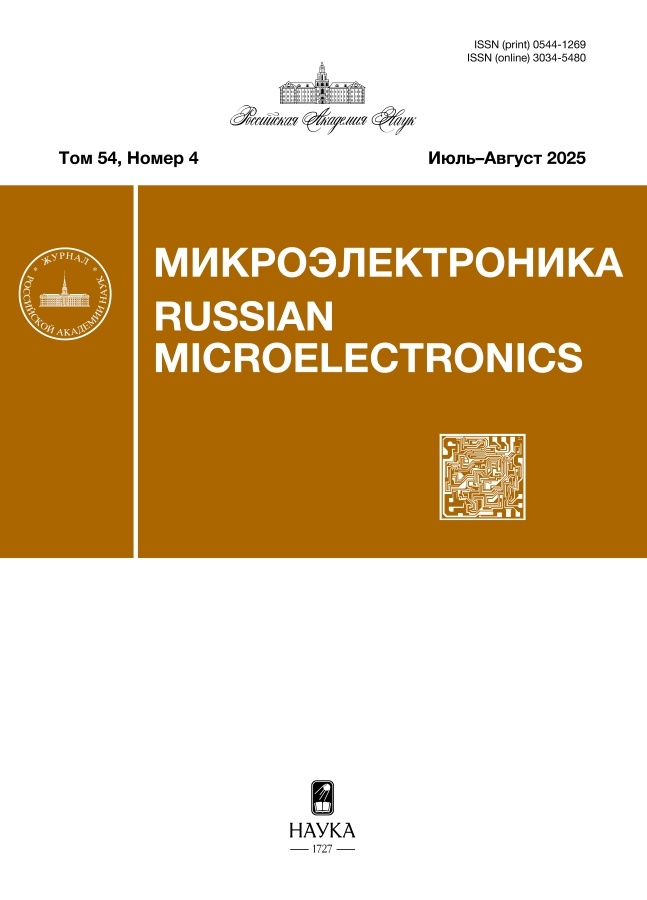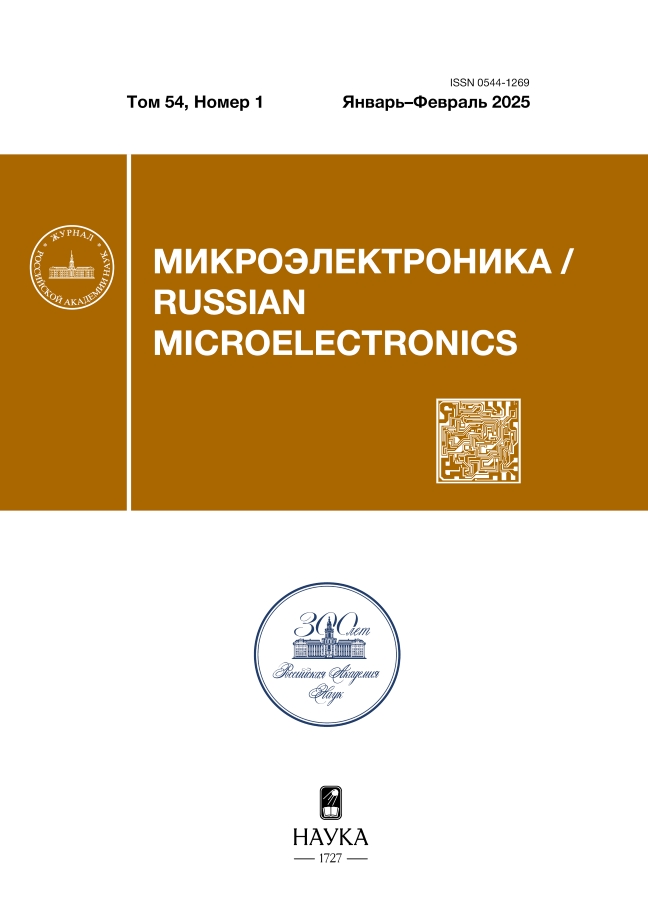Формирование композитных магнитных наноструктур на основе никеля для устройств микроэлектроники и нанодиагностики
- Авторы: Воробьева А.И.1, Тишкевич Д.И.2, Уткина Е.А.1, Ходин А.А.3
-
Учреждения:
- Белорусский государственный университет информатики и радиоэлектроники
- Государственное научно-производственное объединение “Научно-практический центр национальной академии наук Беларуси по материаловедению”
- Государственное научно-производственное объединение “Оптика, оптоэлектроника и лазерная техника”
- Выпуск: Том 54, № 1 (2025)
- Страницы: 34-54
- Раздел: НАНОСТРУКТУРЫ
- URL: https://cijournal.ru/0544-1269/article/view/685018
- DOI: https://doi.org/10.31857/S0544126925010052
- EDN: https://elibrary.ru/GIJOFP
- ID: 685018
Цитировать
Полный текст
Аннотация
Представлены результаты исследования процессов формирования композитного материала на основе массива наноструктур Ni – наностолбиков или нанотрубок, встроенных в тонкий пористый анодный оксид алюминия методом электрохимического осаждения. Наностолбики Ni были получены в режиме постоянного тока (dc-осаждение); нанотрубки в режиме переменного тока (ас-осаждение). Анализ морфологии данных наноструктур показал, что внутренний профиль осадка и микроморфология наноструктур изменяется с увеличением времени осаждения и зависит от характера движения и диаметра пузырьков водорода, выделяющегося при электроосаждении Ni. Исследованы морфологические, структурные и электрохимические свойства полученных композитных материалов методами растровой электронной микроскопии, атомно-силовой микроскопии, рентгеноструктурного анализа, и методом линейной поляризации в потенциодинамическом режиме. Полученные наноструктуры могут быть использованы при изготовлении планарных электродов электрохимических биосенсоров и других устройств нанодиагностики и микроэлектроники.
Полный текст
Об авторах
А. И. Воробьева
Белорусский государственный университет информатики и радиоэлектроники
Автор, ответственный за переписку.
Email: vorobjova@bsuir.by
Белоруссия, Минск
Д. И. Тишкевич
Государственное научно-производственное объединение “Научно-практический центр национальной академии наук Беларуси по материаловедению”
Email: vorobjova@bsuir.by
Белоруссия, Минск
Е. А. Уткина
Белорусский государственный университет информатики и радиоэлектроники
Email: outkina@bsuir.by
Белоруссия, Минск
А. А. Ходин
Государственное научно-производственное объединение “Оптика, оптоэлектроника и лазерная техника”
Email: alhodin@outlook.com
Белоруссия, Минск
Список литературы
- Kelsall R., Hamley I., Geoghegan M. Nanoscale Science and Technology. Wiley: Chichester. 2005.
- Борисенко В.Е., Воробьева А.И., Данилюк А.Л., Уткина Е.А. Наноэлектроника: Теория и практика. Бином: Москва. 2013.
- dos Santos M.V.P., Velo M., Domingos R.D. et al. Electrodeposited nickel nanowires for magnetic-field effect transistor (MagFET) // J. Integrated Circ. Syst. 2016. V. 11. P. 13. https://doi.org/10.29292/jics.v11i1.425
- Ross C.A., Hwang M., Shima M. et al. Micromagnetic behavior of electrodeposited cylinder arrays // Phys. Rev. B. 2002. V. 65. P. 144417. https://doi.org/10.1103/PhysRevB.65.144417
- Proenca M.P., Sousa C.T., Ventura J. et al. Distinguishing nanowire and nanotube formation by the deposition current transients // Nanoscale Res. Lett. 2012. V. 7. P. 280. https://doi.org/10.1186/1556-276X-7-280
- Liu J.P., Fullerton E., Gutfleisch O., Sellmyer D.J. Nanoscale Magnetic Materials and Applications. Berlin: Springer. 2009.
- Vorobjova A.I., Shimanovich D.L., Yanushkevich K.I. et al. Properties of Ni and Ni–Fe nanowires electrochemically deposited into a porous alumina template // Beilstein J. Nanotechnol. 2016. V. 7. P. 1709. https://doi.org/10.3762/bjnano.7.163
- Sun X.C., Huang Y.H., Nikles D.E. FePt and CoPt magnetic nanoparticles film for future high density data storage media // Int. J. Nanotechnol. 2004. V. 1. P. 328. https://doi.org/10.1504/IJNT.2004.004914
- Xu C., Akakuru O.U., Zheng J.J., Wu A.G. Applications of iron oxide-based magnetic nanoparticles in the diagnosis and treatment of bacterial infections // Front. Bioeng. Biotechnol. 2019. V. 7. P. 141. https://doi.org/10.3389/fbioe.2019.00141
- Darton N.J., Ionescu A., Justin Llandro J. (Eds.) Magnetic Nanoparticles in Biosensing and Medicine. Cambridge University Press: Cambridge, UK. 2019.
- Shen W.Z., Cetinel S., Montemagno C. Application of biomolecular recognition via magnetic nanoparticle in nanobiotechnology // J. Nanoparticle Res. 2018. V. 20. P. 130. https://doi.org/10.1007/s11051-018-4232-4
- Makarov A., Windbacher T., Sverdlov V., Selberherr S. CMOS-compatible spintronic devices: A review // Semicond. Sci. Technol. 2016. V. 31. P. 11. https://doi.org/10.1088/0268-1242/31/11/113006
- Giraud M., Delapierre F.D., Wijkhuisen A. et al. Evaluation of in-flow magnetoresistive chip cell-counter as a diagnostic tool // Biosensors 2019. V. 9. P. 105. https://doi.org/10.3390/bios9030105
- Denmark D.J., Bustos-Perez X., Swain A. et al. Readiness of magnetic nanobiosensors for point-of-care commercialization // J. Electron. Mater. 2019. V. 48. P. 4749. https://doi.org/10.1007/s11664-019-07275-7
- Choi J., Gani A.W., Bechstein D.J.B. et al. Portable, one-step, and rapid GMR biosensor platform with smartphone interface // Biosens. Bioelectron. 2016. V. 85. P. 1. https://doi.org/10.1016/j.bios.2016.04.046
- Su D.Q., Wu K., Krishna V.D. et al. Detection of influenza a virus in swine nasal swab samples with a wash-free magnetic bioassay and a handheld giant magnetoresistance sensing system // Front. Microbiol. 2019. V. 10. P. 1077. https://doi.org/10.3389/fmicb.2019.01077
- Mátéfi-Tempfli S., Mátéfi-Tempfli M., Vlad A. Nanowires and nanostructures fabrication using template methods: a step forward to real devices combining electrochemical synthesis with lithographic techniques // J. Mater. Sci.: Mater. Electron. 2009. V. 20(1). P. S249. https://doi.org/10.1007/s10854-008-9568-6
- Woo Lee, Sang-Joon Park. Porous Anodic Aluminum Oxide: Anodization and Templated Synthesis of Functional Nanostructures // Chem. Rev. 2014. V. 114. P. 7487. https://doi.org/10.1021/cr500002z
- Vorobjova A.I., Tishkevich D.I., Outkina E.A. A Study of Nanopillars with Ni Tips Prepared by Porous Anodic Alumina Through-Mask Anodization // Nanomat. 2022. V. 12. P. 1344. https://doi.org/10.3390/nano12081344
- Maximenko A., Fedotova J., Marszałek M. et al. Magnetic characteristics of CoPd and FePd antidot arrays on nanoperforated templates // J. Magn. Magn. Mater. 2016. V. 400. P. 200. https://doi.org/10.1016/j.jmmm.2015.08.057
- Verma N., Singh K.C., Jindal J. Fabrication of nanomaterials on porous anodic alumina template using various techniques // Indian J. Adv. Chem. Sci. 2015. V. 3(3). P. 235. https://doi.org/10.1023/A:1024479827507
- Vorobyova A.I., Outkina E.A., Komar O.M. Study of metal pillar nanostructure formation with thin porous alumina template // Thin Solid Films 2013. V. 548. P. 109. https://doi.org/10.1016/j.tsf.2013.09.016
- Molares M.E., Buschmann V., Dobrev D. et al. Single-crystalline copper nanowires produced by electrochemical deposition in polymeric ion track membranes // Adv. Mater. 2001. V. 13. P. 62. https://doi.org/10.1002/1521-4095(200101)13:1<62::AID-ADMA62>3.0.CO;2-7
- Sousa C.T., Leitao D.C., Proenca M.P. et al. Nanoporous alumina as templates for multifunctional applications // Appl. Phys. Rev. 2014. V. 1. P. 031102. https://doi.org/10.1063/1.4893546
- Jai P., Gerrard E., Nurshahidah A., Derek F. Progress in nano-engineered anodic aluminum oxide membrane developmens // Mater. 2011. V. 4(3). P. 487. https://doi.org/10.3390/ma4030487
- Ying J.Y. Nanoporous systems and templates the unique self–assembly and synthesis of nanostructures // Sci. Spectra 1999. V. 18. P. 56.
- Hao Q., Huang H., Fan X. et al. Facile design of ultra-thin anodic aluminum oxide membranes for the fabrication of plasmonic nanoarray // Nanotech. 2017. V. 28. P. 105301. https://doi.org/10.1088/1361-6528/aa596d
- Wei Q., Fu Y., Zhang G. et al. Rational design of novel nanostructured arrays based on porous AAO templates for electrochemical energy storage and conversion // Nano Energy 2018. V. 55. P. 234. https://doi.org/10.1016/j.nanoen.2018.10.070
- Poinern G.E.J., Le X.T., Hager M. et al. Electrochemical Synthesis, Characterisation, and Preliminary Biological Evaluation of an Anodic Aluminium Oxide Membrane with a pore size of 100 nanometres for a Potential Cell Culture Substrate // Am. J. Biomed. Res. 2013. V. 3(6). P. 119. https://doi.org/10.5923/j.ajbe.20130306.01
- Shaban M., Hamdy H., Shahin F. et al. Uniform and reproducible barrier layer removal of porous anodic alumina membrane // J. Nanosci. Nanotechnol. 2010. Vol. 10(5). P. 3380. https://doi.org/10.1166/jnn.2010.2259.
- Tian M., Xu S., Wang J. et al. Penetrating the Oxide Barrier in Situ and Separating Freestanding Porous Anodic Alumina Films in One Step // Nano. Lett. 2005. V. 5(4). P. 697. https://doi.org/10.1021/nl0501112
- Xiaowei Zhao, Seok-Kyoo Seo, Ung-Ju Lee, Kun-Hong Lee. Controlled Electrochemical Dissolution of Anodic Aluminum Oxide for Preparation of Open-Through Pore Structures // J. Electrochemical Society 2007. V. 154(10). P. 553. https://doi.org/10.1149/1.2759780
- Vorobyova A.I., Outkina E.A., Khodin A.A. Nickel/Alumina nanocomposites by ac electrochemical processing // Applied Physics A. Mater. Sci. Proc. 2016. V. 122(2). P. 109. https://doi.org/10.1007/s00339-016-9611-z
- Воpобьева А.И., Уткина Е.А., Комаp О.М. Одноpодное осаждение никеля в поpы упоpядоченного тонкопленочного оксида алюминия // Микpоэлектpоника. 2013. Т. 42(1). С. 1. https://doi.org/10.7868/S0544126913010079
- Inguanta R., Piazza S., Sunseri C. Influence of electrodeposition techniques on Ni nanostructures // Electrochimica Acta 2008. V. 53. P. 5766. https://doi.org/10.1016/j.electacta.2008.03.045
- Fukunaka Y., Konishi Y., Ishii R. Producing Shape-Controlled Metal Nanowires and Nanotubes by an Electrochemical Method // Electrochem. Solid-State Lett. 2006. V. 9(3). P. 62. https://doi.org/10.1149/1.2165711
- Ranaweera R., Luo L. Electrochemistry of nanobubbles // Current Opinion in Electrochemistry. 2020. – V. 22. P. 102. https://doi.org/10.1016/j.coelec.2020.04.019
- Jadhav A. J., Barigou M. Electrochemically Induced Bulk Nanobubbles // Ind. Eng. Chem. Res. 2021. V. 60 (49). P. 17999. https://doi.org/10.1021/acs.iecr.1c04046
- Brown I.W.M., Bowden M.E., Kemmitt T. et al. Structural and Thermal Characterisation of Nanostructured Alumina Templates // Appl. Phys. 2006. V. 6(3). Р. 557. https://doi.org/10.1016/j.cap.2005.11.060
- Volpe M., Inguanta R., Piazza S., Sunseri C. Optimized bath for electroless deposition of palladium on amorphous alumina membranes // Surf. Coat. Technol. 2006. V. 200(20). P. 5800. https://doi.org/10.1016/j.surfcoat.2005.08.126
- Sulka G.D. Highly Ordered Anodic Porous Alumina Formation by Self-Organized Anodizing // In: Nanostructured Materials in Electrochemistry. Ed. by Ali Eftekhari. WILEY-VCH Verlag GmbH & Co. 2008. ISBN: 978-3-527-31876-6 Р. 1-116.
- Prioteasa P., Petica A., Popa M. et al. Electrochemical deposition of nickel for micro-mechanical systems // Rev. Chim. 2011. V. 62(5). P. 543.
- Pan H., Liu B., Yi J. et al. Growth of single-crystalline Ni and Co nanowires via electrochemical deposition and their magnetic properties // J. Phys. Chem. B 2005. V. 109. P. 3094. https://doi.org/10.1021/jp0451997
- West A.R. Solid State Chemistry and its Applications. John Wiley & Sons Ltd.: Chichester. 1985.
- McCafferty E. Introduction to Сorrosion Science. Springer: New York. 2010.
- Stansbury E.E., Buchanan R.A. Fundamentals of the Electrochemical Corrosion. ASM Int. Geauga, OH, USA. 2000.
- Scully J.R. Polarization resistance method for determination of instantaneous corrosion rates // Corossion 2000. V. 56. P. 199. https://doi.org/10.5006/1.3280536
- Stern M., Geary A.L. Electrochemical polarization // J. Electrochem. Soc. 1957. V. 104. P. 56.
- Rybalka K.V., Beketaeva L.A., Davydov A.D. Estimation of corrosion current by the analysis of polarization curves: Electrochemical kinetics mode // Rus. J. Electrochem. 2014 V. 50. P. 108. https://doi.org/10.1134/S1023193514020025
- Onyeachu B.I., Peng X., Oguzie E.E. et al. Characterizing the electrochemical corrosion behavior of a Ni–28wt.% Al composite coating in 3.5 % NaCl Solution // Port. Electrochim. Acta 2015. V. 33. P. 69(2). https://doi.org/10.4152/pea.201502069
- Qin L.Y., Lian S.J., Jiang Q. Effect of grain size on corrosion behavior of electrodeposited bulk nanocrystalline Ni // Trans. Nonferrous Met. Soc. China 2010. V. 20(1). P. 82. https://doi.org/10.1016/S1003-6326(09)60101-1
- Wang X., Wang B., Zhang L. et al. Effect of different welding processes on electrochemical and corrosion behavior of pure nickel in 1 M NaCl solution // Metals 2017. V. 7(12). P. 532. https://doi.org/10.3390/met7120532
Дополнительные файлы





















